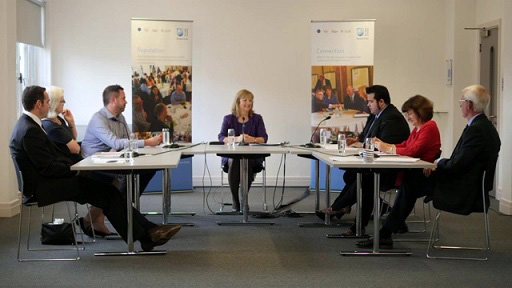3 ‘X wants one thing, Y wants another, Z yet another – they’re all too obstinate to give way!’
Sasha is a manager interested in developing a better team, as you will hear from the audio below (a transcript is also provided).
Transcript
I guess it’s my place as their line manager to intervene, but how do I do that and keep my dignity? They’re all adults, but I wish they’d act that way. Some days it’s like they’re fighting in a school playground. I don’t know if they expect me to be their headteacher, but it’s not something I’m comfortable with. Previous attempts to talk to any of them about this have wound them up further. That said, I’ve got to do something; it can’t go on like this – it seems to be getting personal and out of hand now.
In this scenario, it sounds like effective dialogue between at least three of the team has broken down. Sasha senses the need to intervene, yet may lack the confidence to do so. Sasha is not too specific about what is causing the conflict.
In the next activity, there are a few suggested questions that might help Sasha.
Activity 4
Using the interactive below, click on each of the questions to explore the thinking behind them.
Activity 5
The previous activity raised many useful questions; to follow on, in this activity we seek more positive guidance. You will hear about two sorts of measures to address team conflict; as you will see, not every type of ‘conflict’ is bad for team performance and development:
- Curative measures: mechanisms to intervene and support colleagues involved in conflict. These aim at bringing the team through a conflict situation. (We take the position that, although conflict is inevitable, the destructive outcome of conflict is certainly not inevitable.)
- Preventative measures: setting up team structures and organising your teams in a way that helps reduce the frequency and impact of negative conflict. (We take the position that conflict is inevitable and cannot be eradicated.)
Now watch the following video extract from a round-table discussion involving business leaders and academics from The Open University. The discussion is entitled Management Now: tomorrow’s demands on today’s leaders. The title is informative because proficient management of conflict requires planning for the future: establishing preventative measures, and being prepared to apply curative measures when needed.

Transcript: Webinar
- Note down one curative measure; and one preventative measure suggested by the panellists.
- How do you think ‘being flexible’ in dealing with conflict might be useful to a team leader?
- Describe a situation (one you’ve observed, or one you imagine) in which a manager might do well to keep out of a conflict situation between team members.
Discussion
- Kevin Sampson suggests regular meetings where ‘sins’ can be confessed. We interpret this as top-down encouragement by a manager to their team to be open about things that haven’t gone well; e.g. areas where conflict may have arisen. Developing a tolerant and open culture, through the preventative measure of scheduling these meetings, gives an opportunity for others in the team to support those ‘in conflict’ –in turn this can be seen as a curative measure: the team being involved in open dialogue about particular conflicts.
- Team members feel more comfortable with a consistent line or approach being taken by bosses. They may describe a manager as ‘harsh but fair, even handed’. However, different conflict situations require different solutions. The manager needs a repertoire of ways of approaching conflict – for example, some situations would benefit from a highly ‘visible’ intervention by the manager, whilst others may benefit more from a low-level, subtle approach – ‘quiet words’ with the individuals involved.
- Allowing the parties in a conflict to resolve their own difficulties can have the effect of empowering them, perhaps even enhancing their future relationship. This isn’t the same as a manager ‘doing nothing’ – they may need to monitor the situation very closely to instigate or facilitate communication between the parties. Crucially, managers should be prepared to change their approach in light of how a conflict develops.
Take home: although there is such a thing as ‘creative conflict’, a little bit of the ‘wrong’ kind of conflict can be devastating, both to individual wellbeing and team effectiveness. To maintain or support the re-establishing of trust within the team, managers need to interrogate the background to conflict and be prepared to intervene. Intervention does not always mean a direct and heavy-handed resolution by a ‘superhero’ boss.
Extension: watch the other three sections of the Management Now roundtable discussion [Tip: hold Ctrl and click a link to open it in a new tab. (Hide tip)] (the full video is 30 minutes, including the section used in the activity above). Reflect on the extent to which participants in this video refer to communication and team management skills as key to preparing for future business demands.
